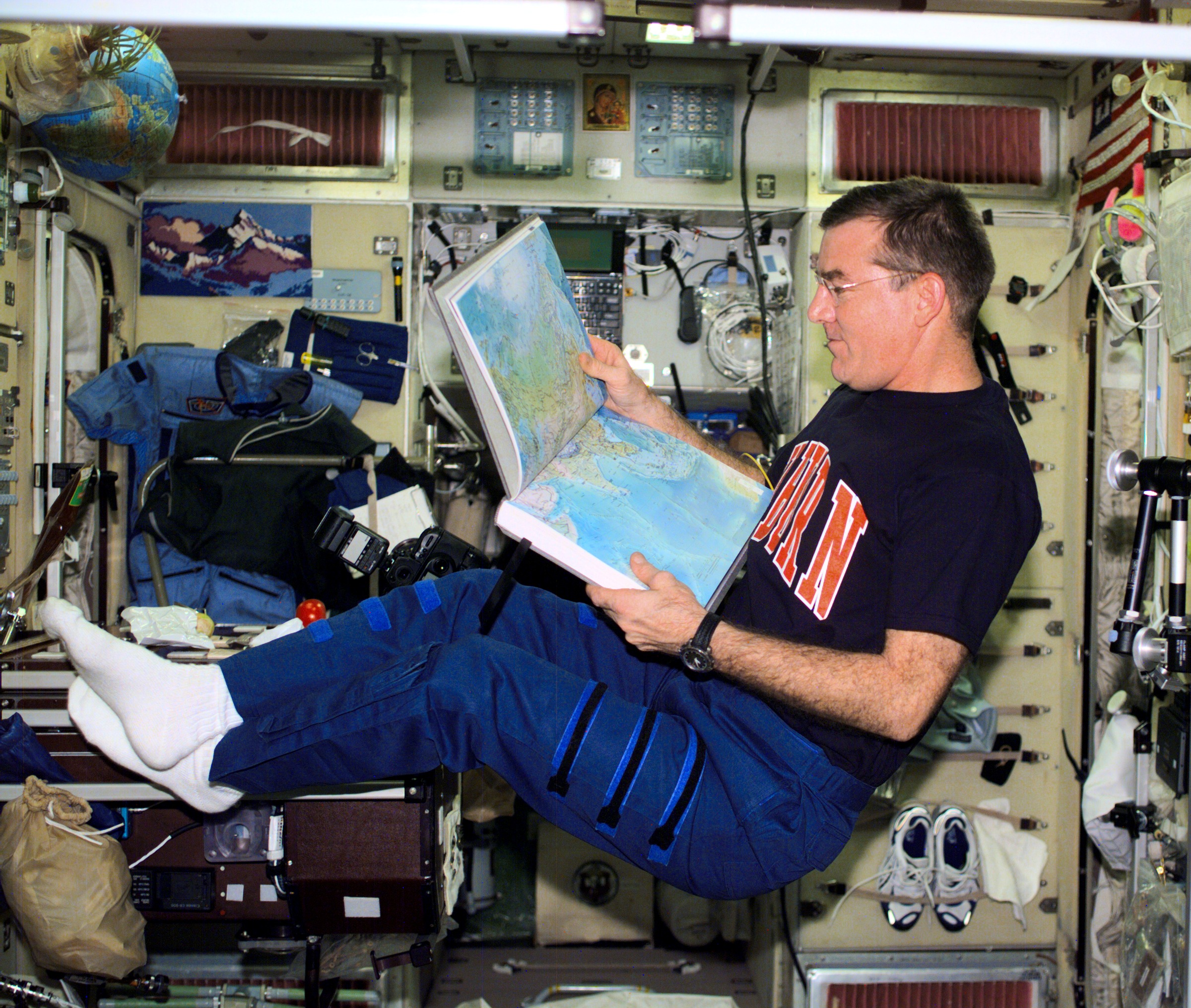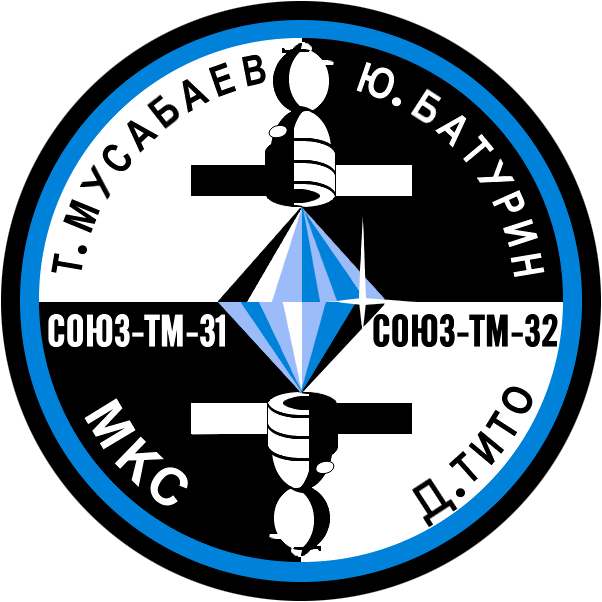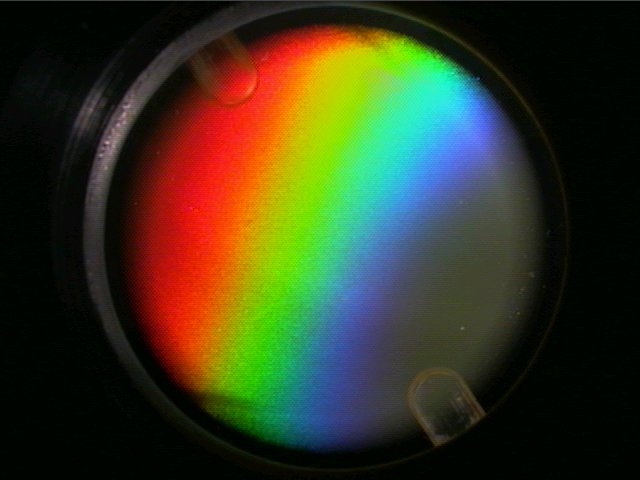Expedition 2 on:
[Wikipedia]
[Google]
[Amazon]
Expedition 2 (also called ISS EO-2) was the second long-duration
 All three crew members had visited the International Space Station together in May 2000 aboard
All three crew members had visited the International Space Station together in May 2000 aboard
 Expedition 2, the second long-term crew for the International Space Station arrived in March 2001. They returned to Earth on mission
Expedition 2, the second long-term crew for the International Space Station arrived in March 2001. They returned to Earth on mission
 On the day after the Space Shuttle undocked, the Russian spacecraft
On the day after the Space Shuttle undocked, the Russian spacecraft
 Two science racks, known as EXPRESS Racks No. 1 and 2, were delivered to the station in April aboard
Two science racks, known as EXPRESS Racks No. 1 and 2, were delivered to the station in April aboard
Expedition 2 Photography
{{ISS expeditions Expedition 02 2001 in spaceflight Dennis Tito
spaceflight
Spaceflight (or space flight) is an application of astronautics to fly spacecraft into or through outer space, either with or without humans on board. Most spaceflight is uncrewed and conducted mainly with spacecraft such as satellites in or ...
aboard the International Space Station
The International Space Station (ISS) is the largest modular space station currently in low Earth orbit. It is a multinational collaborative project involving five participating space agencies: NASA (United States), Roscosmos (Russia), JAXA ...
, immediately following Expedition 1
Expedition 1 was the first long-duration stay on the International Space Station (ISS). The three-person crew stayed aboard the station for 136 days, from November 2000 to March 2001. It was the beginning of an uninterrupted human presence on the ...
. Its three-person crew stayed aboard the station from March to August 2001. In addition to station maintenance, the crew assisted in several station assembly missions, welcomed the first space tourist
Space tourism is human space travel for recreational purposes. There are several different types of space tourism, including orbital, suborbital and lunar space tourism.
During the period from 2001 to 2009, seven space tourists made eight s ...
Dennis Tito
Dennis Anthony Tito (born August 8, 1940) is an American engineer and entrepreneur. In mid-2001, he became the first space tourist to fund his own trip into space, when he spent nearly eight days in orbit as a crew member of ISS EP-1, a visitin ...
, and conducted some scientific experiments.
The crew consisted of one Russia
Russia (, , ), or the Russian Federation, is a List of transcontinental countries, transcontinental country spanning Eastern Europe and North Asia, Northern Asia. It is the List of countries and dependencies by area, largest country in the ...
n, Commander Yury Usachev, and two American flight engineers Susan Helms and James Voss. The three had been to the station briefly in the previous year, during the 10-day mission STS-101
STS-101 was a Space Shuttle mission to the International Space Station (ISS) flown by Space Shuttle '' Atlantis''. The mission was a 10-day mission conducted between 19 May 2000 and 29 May 2000. The mission was designated 2A.2a and was a resuppl ...
in May 2000.
The Expedition 2 crew was brought to the station aboard Space Shuttle
The Space Shuttle is a retired, partially reusable low Earth orbital spacecraft system operated from 1981 to 2011 by the U.S. National Aeronautics and Space Administration (NASA) as part of the Space Shuttle program. Its official program na ...
''Discovery'' during mission STS-102
STS-102 was a Space Shuttle mission to the International Space Station (ISS) flown by Space Shuttle '' Discovery'' and launched from Kennedy Space Center, Florida. STS-102 flew in March 2001; its primary objectives were resupplying the ISS and ...
. The Expedition's increment began when ''Discovery'' docked on 10 March 2001, bringing Expedition 1 to an end. In addition to the Space Shuttle flights which brought the crew to and from the station, there were two visiting Space Shuttle missions and one Soyuz mission which docked with the ISS during Expedition Two.
In August ''Discovery'' returned to rotate the long-duration crews again, bringing the crew of the next expedition. The Expedition 2 increment ended when ''Discovery'' undocked from the station on 20 August 2001.
Crew
 All three crew members had visited the International Space Station together in May 2000 aboard
All three crew members had visited the International Space Station together in May 2000 aboard STS-101
STS-101 was a Space Shuttle mission to the International Space Station (ISS) flown by Space Shuttle '' Atlantis''. The mission was a 10-day mission conducted between 19 May 2000 and 29 May 2000. The mission was designated 2A.2a and was a resuppl ...
. In addition to this spaceflight, the Expedition 2 Commander Yuri Usachev also had two other spaceflights, both of which were long-duration missions aboard ''Mir
''Mir'' (russian: Мир, ; ) was a space station that operated in low Earth orbit from 1986 to 2001, operated by the Soviet Union and later by Russia. ''Mir'' was the first modular space station and was assembled in orbit from 1986 to&n ...
'' ( EO-15 and EO-21).
In addition to STS-101, flight engineer Susan Helms had three other spaceflights, all of which were Space Shuttle missions ( STS-54, STS-64
STS-64 was a Space Shuttle ''Discovery'' mission that was set to perform multiple experiment packages. STS-64 was launched from Kennedy Space Center, Florida, on 9 September 1994, and landed back on 20 September 1994 at Edwards Air Force Base.
...
, STS-78). James Voss also had three other spaceflights, all of which were Space Shuttle missions (STS-44
STS-44 was a NASA Space Shuttle mission using '' Atlantis'' that launched on November 24, 1991. It was a U.S. Department of Defense (DoD) space mission.
Crew
Backup crew
Crew seating arrangements
Mission highlights
The launch wa ...
, STS-53, STS-69
STS-69 was a Space Shuttle ''Endeavour'' mission, and the second flight of the Wake Shield Facility (WSF). The mission launched from Kennedy Space Center, Florida on 7 September 1995. It was the 100th successful crewed NASA spaceflight, not incl ...
).
Mission highlights
 Expedition 2, the second long-term crew for the International Space Station arrived in March 2001. They returned to Earth on mission
Expedition 2, the second long-term crew for the International Space Station arrived in March 2001. They returned to Earth on mission STS-105
STS-105 was a mission of the Space Shuttle ''Discovery'' to the International Space Station, launched from Kennedy Space Center, Florida, 10 August 2001. This mission was ''Discoverys final mission until STS-114, because ''Discovery'' was gro ...
, 22 August 2001 after having spent 163 days aboard the station and 167 days in space. Only Voss performed a spacewalk on STS-101, along with Jeffrey Williams.
During this expedition, research facilities launched to the Space Station included a Human Research Facility, two EXPRESS (Expedite the Processing of Experiments to the Space Station) Racks, one of which contains the Active Rack Isolation System and the Payload Equipment Restraint System. They also prepared the Destiny laboratory to enable upcoming experiments to be conducted.
A major focus was on gaining a better understanding of how to protect crew members from radiation while working and living in space. Radiation exposure in high doses over long periods of time can damage human cells and cause cancer or injury to the central nervous system.
Launch and docking
The three-member Expedition 2 crew successfully launched on 8 March 2001 on Space Shuttle ''Discovery'' during missionSTS-102
STS-102 was a Space Shuttle mission to the International Space Station (ISS) flown by Space Shuttle '' Discovery'' and launched from Kennedy Space Center, Florida. STS-102 flew in March 2001; its primary objectives were resupplying the ISS and ...
. They docked with the International Space Station on 10 March, but the Expedition 2 increment didn't begin until the previous crew undocked from the station on 18 March.
STS-100
The first visitors to the station during Expedition 2 was the crew ofSTS-100
STS-100 was a Space Shuttle mission to the International Space Station (ISS) flown by Space Shuttle '' Endeavour''. STS-100 launch on 19 April 2001, and installed the ISS Canadarm2 robotic arm.
Crew
Mission highlights
The highest priori ...
, when they docked Space Shuttle ''Endeavour'' with the ISS on 21 April 2001. They spent eight days docked to the station. The primary objective of this mission was to deliver and install the Canadarm2
The Mobile Servicing System (MSS), is a robotic system on board the International Space Station (ISS). Launched to the ISS in 2001, it plays a key role in station assembly and maintenance; it moves equipment and supplies around the station, supp ...
on the ISS, which is a robotic arm similar to the Canadarm
Canadarm or Canadarm1 (officially Shuttle Remote Manipulator System or SRMS, also SSRMS) is a series of robotic arms that were used on the Space Shuttle orbiters to deploy, manoeuvre, and capture payloads. After the Space Shuttle ''Columbia' ...
which is used on some Space Shuttle flights. A later mission in 2002, STS-111
STS-111 was a space shuttle mission to the International Space Station (ISS) flown by Space Shuttle ''Endeavour''. STS-111 resupplied the station and replaced the Expedition 4 crew with the Expedition 5 crew. It was launched on 5 June 2002, fr ...
, would deliver a movable base platform which would allow the Canadarm2 to have a larger range.ISS EP-1
 On the day after the Space Shuttle undocked, the Russian spacecraft
On the day after the Space Shuttle undocked, the Russian spacecraft Soyuz TM-32
Soyuz TM-32 was a crewed Soyuz spaceflight which was launched on April 28, 2001, and docked with the International Space Station two days later. It launched the crew of the visiting mission ISS EP-1, which included the first paying space touris ...
docked to the station, carrying two cosmonauts with previous spaceflight experience, as well as Dennis Tito
Dennis Anthony Tito (born August 8, 1940) is an American engineer and entrepreneur. In mid-2001, he became the first space tourist to fund his own trip into space, when he spent nearly eight days in orbit as a crew member of ISS EP-1, a visitin ...
, the first ever space tourist
Space tourism is human space travel for recreational purposes. There are several different types of space tourism, including orbital, suborbital and lunar space tourism.
During the period from 2001 to 2009, seven space tourists made eight s ...
. This 8 day mission is sometimes referred to as ''ISS EP-1'', ''ISS-2S'', ''Soyuz 2 Taxi Flight'', or simply by its launching spacecraft ''Soyuz TM-32''. The Commander of this visiting mission was Kazakh cosmonaut Talgat Musabayev
Talgat Amangeldyuly Musabayev ( kk, Талғат Аманкелдіұлы Мұсабаев, ''Talğat Amankeldıūly Mūsabaev''; born 7 January 1951) is a Kazakh test pilot and former cosmonaut who flew on three spaceflights. His first two spa ...
, who had previously been on two long-duration missions aboard the space station ''Mir
''Mir'' (russian: Мир, ; ) was a space station that operated in low Earth orbit from 1986 to 2001, operated by the Soviet Union and later by Russia. ''Mir'' was the first modular space station and was assembled in orbit from 1986 to&n ...
'' in the 1990s. The other crew member of ISS EP-1 was Yuri Baturin
Yuri Mikhailovich Baturin (russian: Юрий Михайлович Батурин; born 12 June 1949, in Moscow), is a Russian cosmonaut and former politician.
Baturin graduated from the Moscow Institute of Physics and Technology in 1973, and is t ...
, who had one other spaceflight, Mir EP-4, which was a visiting mission to ''Mir'' launched with the spacecraft Soyuz TM-28
TM-28 was a Soyuz mission to the Mir space station.
Crew
Mission Accomplishments
*Docked with Mir.
*Baturin became the first Russian politician in space.
*Padalka and Avdeyev performed an EVA on 15.09.1998 (30 m) into the module Spektr (new ...
. Baturin's first mission occurred during the long-duration mission Mir EO-25
''Mir'' (russian: Мир, ; ) was a space station that operated in low Earth orbit from 1986 to 2001, operated by the Soviet Union and later by Russia. ''Mir'' was the first modular space station and was assembled in orbit from 1986 to&n ...
, so he and Musabayev had already been in space together prior to ISS EP-1; in fact both were landed with the spacecraft Soyuz TM-27
Soyuz TM-27 was a Russian spaceflight that ferried cosmonauts and supplies to the Russian space station Mir. It was the 33rd expedition to Mir. It was launched by a Soyuz-U rocket from Baikonur Cosmodrome on January 29, 1998. The main mission ...
in August 1998.
STS-104
In July, Space Shuttle ''Atlantis'' docked with the station for an eight-day visit as a part ofSTS-104
STS-104 was a Space Shuttle mission to the International Space Station (ISS) flown by Space Shuttle ''Atlantis''. Its primary objectives were to install the ''Quest'' Joint Airlock and help perform maintenance on the International Space Statio ...
. The main objective of this mission was to install the Quest Joint Airlock
The ''Quest'' Joint Airlock, previously known as the Joint Airlock Module, is the primary airlock for the International Space Station. ''Quest'' was designed to host spacewalks with both Extravehicular Mobility Unit (EMU) spacesuits and Orlan s ...
onto the station.
The STS-104 crew performed 3 spacewalks
Extravehicular activity (EVA) is any activity done by an astronaut in outer space outside a spacecraft. In the absence of a breathable Earthlike atmosphere, the astronaut is completely reliant on a space suit for environmental support. EVA inc ...
.
;First spacewalk; Joint Airlock Installation
The first spacewalk occurred on 15 July, and focused on installation of the Quest Joint Airlock. The spacewalkers helped as Susan Helms, using the station's robotic arm, lifted the new station airlock from Atlantis' payload bay and moved it to the station's Unity module. During much of the 5 hour, 59 minute spacewalk, Jim Reilly worked from a foot platform attached to the end of the shuttle's robotic arm, operated by Janet Kavandi. After the spacewalk, crew members inside the Station attached connections to the airlock to prevent thermal damage.
;Second spacewalk
The second spacewalk which happened on 18 July, lasted 6 hours, 29 minutes. The internal hatches between the shuttle and station were closed at the end of Flight Day 6 so Atlantis' cabin pressure could be lowered in preparation for the second spacewalk. The major objective was to attach and connect an oxygen and a nitrogen tank. Susan Helms operated the station arm to lift the tanks from the shuttle's payload bay and maneuver them to the new airlock. At the airlock, Mike Gernhardt and Jim Reilly latched the tanks in place and connected cables and hoses. The spacewalkers were able to get ahead of schedule and also install another oxygen tank, leaving only one tank to be connected on the third spacewalk.
;Third spacewalk
The third spacewalk, which occurred on 21 July, was the first spacewalk based out of the new Quest Joint Airlock, and lasted 4 hours, 2 minutes. Primary objective was to install the final nitrogen tank outside the airlock. This spacewalk tested a new protocol developed by former commercial diver Mike Gernhardt: essentially exercising while breathing oxygen to purge nitrogen from the spacewalkers' bodies.
Undocking and landing
In August, Space Shuttle ''Discovery'' returned to the station during the missionSTS-105
STS-105 was a mission of the Space Shuttle ''Discovery'' to the International Space Station, launched from Kennedy Space Center, Florida, 10 August 2001. This mission was ''Discoverys final mission until STS-114, because ''Discovery'' was gro ...
, which carried the three Expedition 2 crew members back down to Earth. They undocked from the station on 20 August 2001, marking the end of the Expedition 2 increment.
Mission patch
The International Space Station Expedition Two patch depicts the Space Station as it appeared during the time the second crew was on board. The Station flying over the Earth represents the overall reason for having a space station: to benefit the world through scientific research and international cooperation in space. The number 2 is for the second expedition and is enclosed in the Cyrillic MKS and Latin ISS which are the respective Russian and English abbreviations for the International Space Station. The United States and Russian flags show the nationalities of the crew indicating the joint nature of the program. When asked about the stars in the background, a crew spokesperson said they "...represent the thousands of space workers throughout the ISS partnership who have contributed to the successful construction of our International Space Station."Science activities
 Two science racks, known as EXPRESS Racks No. 1 and 2, were delivered to the station in April aboard
Two science racks, known as EXPRESS Racks No. 1 and 2, were delivered to the station in April aboard STS-100
STS-100 was a Space Shuttle mission to the International Space Station (ISS) flown by Space Shuttle '' Endeavour''. STS-100 launch on 19 April 2001, and installed the ISS Canadarm2 robotic arm.
Crew
Mission highlights
The highest priori ...
. One of the experiments on EXPRESS Rack No. 2 was the Experiment of Physics of Colloid
A colloid is a mixture in which one substance consisting of microscopically dispersed insoluble particles is suspended throughout another substance. Some definitions specify that the particles must be dispersed in a liquid, while others extend ...
s in Space. Several different colloid mixtures were studied, and the analysis is still underway.
References
NASA
External links
Expedition 2 Photography
{{ISS expeditions Expedition 02 2001 in spaceflight Dennis Tito